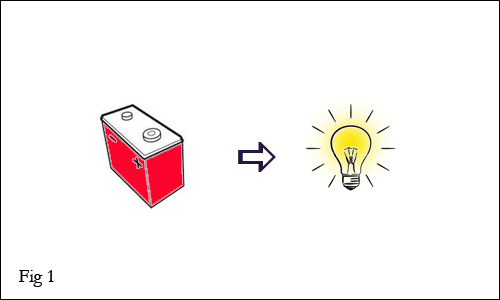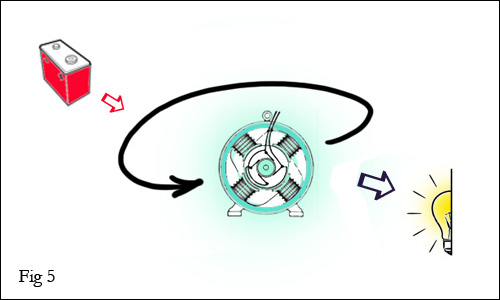The concept of overunity, that is, creating more energy output from a system than you put into it, is according to our current understanding of the physical universe, ((A current understanding that is built on hundreds of years of good science, in case that wasn’t obvious.)) completely impossible. The physics behind why this is so is not that complicated to grasp, but there’s an even easier way to demonstrate why claims of overunity are preposterous.
Let’s just start with a simple power source and a simple electrical device. For the sake of argument, we’re going to say that a battery supplies exactly enough power to light a single light globe:

Pretty straightforward. This is the kind of power generation with which we are all familiar. The energy doesn’t come from just ‘nowhere’ – it’s stored in the battery in the form of potential energy and released via a chemical reaction. Eventually the ‘stored’ power runs out and we need to replace it.
We could also power the light bulb from a generator:

In this case, the wind provides power to turn a generator and that rotation is converted into electrical energy. Again, the energy doesn’t just come from nowhere. It is the direct result of work done by the wind. Sometimes we choose to convert that energy (done by the work of wind, or the sun, or coal or radioactive decay) into potential energy via a chemical reaction, so that we can store it up and use it later. That’s the battery scenario above.
Now, what the overunity zealots are claiming is that, through the use of a device of some kind (usually involving rotating magnets), the energy that is produced by the machine is greater than the energy required to drive it:

In this case, for the sake of simplicity, I’m saying that the overunity device is taking the output of the battery and creating a 50% increase in power at its output (the 50% increase in efficiency claim is something that you hear frequently in the free energy community, but it is, as we shall see, irrelevant whether the figure is 50%, 10%, 2% or even 0.0001% – the mathematical consequences lead to the same place). In other words, for every unit of power delivered into the engine, one and a half units is output.
But, I hear you say, maybe there is something in that! You still have to use a power source for your machine, so it’s not like it’s pulling the energy out of thin air! Maybe the engine is just somehow making the power production more efficient due to the magical effect of magnets! And that, of course is what sucks most simple-minded people into believing this deeply flawed situation. Here’s why.
Let’s say instead of one battery driving an overunity engine, you had two of the darn things. Well, it doesn’t take a genius to see that the output of these two machines will provide enough power to light three light globes. Or… three overunity engines! Which, in turn, could light FOUR AND A HALF light globes!

OK, well, I guess you saw what just happened. From the initial investment power of two batteries we have now ended up with a power output of 4.5 batteries. We have in fact more than doubled our original energy contribution in one generation of technical amplification. It doesn’t take much thinking to see what kind of peril we are now in. Here we have the potential to arrive at an INFINITE power output from just a trivial amount of power input. Now, while infinite energy might not be technically possible, ((You must, for one thing, eventually come up against the problem of running out of stuff from which to build your machines.)) it is also plain that just a modest technical investment would give us more energy than we can calculate to exist in the entire universe. ((As I said above, the actual claimed increase in efficiency above the nominal output is irrelevant. ANY amount of surplus energy is anomalous and can be used to create a runaway trend toward infinite power. Of course, the smaller the over-efficiency claimed, the more steps it takes.)) This situation, in and of itself, should give any thinking person pause.
But, as they say in the knife commercials, wait – there’s more! The free energy provocateurs are not content with a situation that is merely impossible! They want to push through to the truly absurd.
Follow me a little longer here: What if, instead of connecting the output of your overunity device to another engine, you connected some of it back into itself??? So, let’s say that instead of using a battery to power the overunity engine, we just used it to boot the machine into action, and, once it was running happily, we just flipped a switch that disconnected the battery and connected the machine’s own output back into its input.

Crikey! The machine is now powering itself. And with energy to spare! The half-a-light-bulb-worth of additional power has come from nowhere! Well, it should be pretty obvious that we now have our head well and truly stuck in the bannisters. The logical extension of this scenario is that we could use the output of the above configuration to ramp up the power in a similar way to how we proceeded in Figure 4, and arrive, once more at a theoretical infinite energy output. Only this time we wouldn’t be putting any initial energy at all into the system! ((You don’t, in fact, even need a battery to start the overunity engine up – any energy would do. You could, for instance, just hand-crank it into action. This is exactly how the Lutec engine has been demonstrated to be set in motion.))
In other words (if it isn’t immediately obvious): we would be creating an infinite amount of energy from absolutely zero energy input.
And, just in case your brain is not already reeling with the silliness of this nonsensical idea, the free energy proponents frequently suggest that a 50% increase in power output, such as I’ve used in my examples above, is a modest expectation, and often boast that their machines could produce as much as a 200% or more increase in energy! ((Steorn has publicly claimed that their Orbo overunity device is capapable of 150% to 200% efficiency)) Even a very quick back-of-the-envelope calculation demonstrates how truly absurd this is.

In my deconstruction of the inherent logical flaws behind the overunity/free energy concept, I have demonstrated only a mathematical reductio ad absurdum illustration of how quickly the concept runs aground. It is, I think, completely convincing in its own right. Even so, there’s a whole other line of argument squarely based in the realm of physics that explains why you can’t get energy out of nowhere, and why a machine cannot produce more energy than it consumes. There is also a comprehensive historical record of perpetual motion and free energy machines that shows an embarrassing procession of failure upon failure upon failure. Not only does the math and the physics say that they won’t work, the prediction is entirely supported by the complete lack of any physical evidence from the thousands of people who have put extraordinary quantities of time, money and wistful thinking into making these odd devices.



